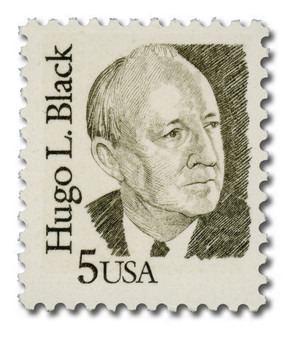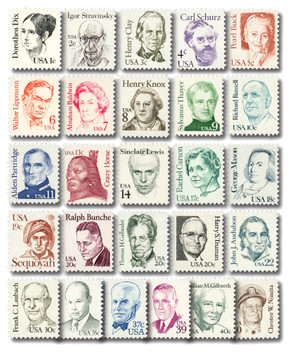
U.S. #1859
1980 19¢ Sequoyah
Great Americans
- 1st stamp in the Great Americans Series
- The only Great Americans stamp with a five-digit plate number
- Honors the creator of the Cherokee written language
Stamp Category: Definitive
Series: Great Americans
Value: 19¢; international post card rate
First Day of Issue: December 27, 1980
First Day City: Tahlequah, Oklahoma
Printed by: Bureau of Engraving & Printing
Printing Method: Engraved
Format: Panes of 100
Perforations: 11 x 10.5
Color: Brown
Why the stamp was issued: This inaugural stamp in the Great Americans series paid the new international post card rate that went into effect on January 1, 1981.
About the stamp design: Designed by Roy Andersen, the portrait on this stamp was based on a full-color 1965 painting by Charles Banks Wilson, which hangs in the Oklahoma state capital.
About the printing process: This was the only Great Americans stamp with the five-digit plate number.
First Day City: The First Day ceremony for this stamp was held at the Cherokee Heritage Center in Tahlequah, Oklahoma.
About the Great Americans Series: The Great Americans Series was created to replace the Americana Series. The new series would be characterized by a standard definitive size, simple design, and monochromatic colors.
This simple design included a portrait, “USA,” the denomination, the person’s name, and in some cases, their occupation or reason for recognition. The first stamp in the new series was issued on December 27, 1980. It honored Sequoyah and fulfilled the new international postcard rate that would go into effect in January 1981.
The Great Americans Series would honor a wider range of people than the previous Prominent Americans and Liberty Series. While those series mainly honored presidents and politicians, the Great Americans Series featured people from many fields and ethnicities. They were individuals who were leaders in education, the military, literature, the arts, and human and civil rights. Plus, while the previous series only honored a few women, the Great Americans featured 15 women. This was also the first definitive series to honor Native Americans, with five stamps.
The Bureau of Engraving and Printing (BEP) produced most of the stamps, but private firms printed some. Several stamps saw multiple printings. The result was many different varieties, with tagging being the key to understanding them. Though there were also differences in perforations, gum, paper, and ink color.
The final stamp in the series was issued on July 17, 1999, honoring Justin S. Morrill. Spanning 20 years, the Great Americans was the longest-running US definitive series. It was also the largest series of face-different stamps, with a total of 63.
History the stamp represents: On February 21, 1828, the first Native American newspaper, utilizing Sequoyah’s Cherokee Syllabary, was printed.
Sequoyah was born around 1770 into a family respected for its knowledge of Cherokee tribal traditions. Accounts of Sequoyah’s early life vary, but it is known that by 1809, he was a silversmith in present-day Alabama.
Around 1809, Sequoyah became interested in creating a system of writing for the Cherokee language. At first he tried to create a character for each word, but he eventually developed a system of symbols to represent each syllable. Basing some of his work on the Roman, and possibly Cyrillic, alphabets, Sequoyah developed a written language of 86 characters. Because each symbol represents a whole syllable, or mora, as opposed to individual speech sounds, or phonemes, Sequoyah’s system is classified as a syllabary instead of an alphabet. In 1821, after twelve years of work, Sequoyah completed his writing system. He hoped the syllabary would allow the Cherokee to remain independent of whites, and wanted to record ancient traditions in a permanent form.
Initially, many doubted its value, so Sequoyah taught the symbols to his daughter Ah-yo-ka. While many of the locals were impressed with his writing system, the medicine men he showed it to believed he was possessed by evil spirits. Despite the negative reaction of the medicine men, Sequoyah showed his syllabary to a group of Chickamauga warriors, who were impressed by it. Soon after, schools were being filled with Cherokees wanting to learn the new writing language. By 1823, the syllabary was in widespread use among the Cherokees, and in 1825, it was made the official written language of the Cherokee Nation.
Around this time, the Cherokee Nation was under frequent pressure from the nearby states to abandon their claim to their land, or move to a territory west of the Mississippi River. The Cherokee General Council believed that their people needed to be informed of the situation and remain united. So they had a special printing press made using Sequoyah’s Cherokee syllabary. The press would be used to produce the first Native American newspaper in the US.
The newspaper, the Cherokee Phoenix, was first published on February 21, 1828, and featured articles in both English and Cherokee. Printed once a week, the Phoenix presented official laws and documents of the Cherokee nation as well as local and national news. It also had articles about the Cherokee progress in the “arts of civilized life,” stories about temperance and Christian living, as well as short fictional stories.
In 1829, the paper was renamed the Cherokee Phoenix and Indians’ Advocate, to reflect the increased focus on the ongoing removal crisis. In 1835, a Georgia militia unit confiscated the printing press to stop them from printing anti-removal materials. Later that year the Treaty of New Echota was signed (though it did not have the support of the Cherokee National Council or a large majority of the Cherokee population), and the Cherokee were forcibly removed from lands east of the Mississippi River.
U.S. #1859
1980 19¢ Sequoyah
Great Americans
- 1st stamp in the Great Americans Series
- The only Great Americans stamp with a five-digit plate number
- Honors the creator of the Cherokee written language
Stamp Category: Definitive
Series: Great Americans
Value: 19¢; international post card rate
First Day of Issue: December 27, 1980
First Day City: Tahlequah, Oklahoma
Printed by: Bureau of Engraving & Printing
Printing Method: Engraved
Format: Panes of 100
Perforations: 11 x 10.5
Color: Brown
Why the stamp was issued: This inaugural stamp in the Great Americans series paid the new international post card rate that went into effect on January 1, 1981.
About the stamp design: Designed by Roy Andersen, the portrait on this stamp was based on a full-color 1965 painting by Charles Banks Wilson, which hangs in the Oklahoma state capital.
About the printing process: This was the only Great Americans stamp with the five-digit plate number.
First Day City: The First Day ceremony for this stamp was held at the Cherokee Heritage Center in Tahlequah, Oklahoma.
About the Great Americans Series: The Great Americans Series was created to replace the Americana Series. The new series would be characterized by a standard definitive size, simple design, and monochromatic colors.
This simple design included a portrait, “USA,” the denomination, the person’s name, and in some cases, their occupation or reason for recognition. The first stamp in the new series was issued on December 27, 1980. It honored Sequoyah and fulfilled the new international postcard rate that would go into effect in January 1981.
The Great Americans Series would honor a wider range of people than the previous Prominent Americans and Liberty Series. While those series mainly honored presidents and politicians, the Great Americans Series featured people from many fields and ethnicities. They were individuals who were leaders in education, the military, literature, the arts, and human and civil rights. Plus, while the previous series only honored a few women, the Great Americans featured 15 women. This was also the first definitive series to honor Native Americans, with five stamps.
The Bureau of Engraving and Printing (BEP) produced most of the stamps, but private firms printed some. Several stamps saw multiple printings. The result was many different varieties, with tagging being the key to understanding them. Though there were also differences in perforations, gum, paper, and ink color.
The final stamp in the series was issued on July 17, 1999, honoring Justin S. Morrill. Spanning 20 years, the Great Americans was the longest-running US definitive series. It was also the largest series of face-different stamps, with a total of 63.
History the stamp represents: On February 21, 1828, the first Native American newspaper, utilizing Sequoyah’s Cherokee Syllabary, was printed.
Sequoyah was born around 1770 into a family respected for its knowledge of Cherokee tribal traditions. Accounts of Sequoyah’s early life vary, but it is known that by 1809, he was a silversmith in present-day Alabama.
Around 1809, Sequoyah became interested in creating a system of writing for the Cherokee language. At first he tried to create a character for each word, but he eventually developed a system of symbols to represent each syllable. Basing some of his work on the Roman, and possibly Cyrillic, alphabets, Sequoyah developed a written language of 86 characters. Because each symbol represents a whole syllable, or mora, as opposed to individual speech sounds, or phonemes, Sequoyah’s system is classified as a syllabary instead of an alphabet. In 1821, after twelve years of work, Sequoyah completed his writing system. He hoped the syllabary would allow the Cherokee to remain independent of whites, and wanted to record ancient traditions in a permanent form.
Initially, many doubted its value, so Sequoyah taught the symbols to his daughter Ah-yo-ka. While many of the locals were impressed with his writing system, the medicine men he showed it to believed he was possessed by evil spirits. Despite the negative reaction of the medicine men, Sequoyah showed his syllabary to a group of Chickamauga warriors, who were impressed by it. Soon after, schools were being filled with Cherokees wanting to learn the new writing language. By 1823, the syllabary was in widespread use among the Cherokees, and in 1825, it was made the official written language of the Cherokee Nation.
Around this time, the Cherokee Nation was under frequent pressure from the nearby states to abandon their claim to their land, or move to a territory west of the Mississippi River. The Cherokee General Council believed that their people needed to be informed of the situation and remain united. So they had a special printing press made using Sequoyah’s Cherokee syllabary. The press would be used to produce the first Native American newspaper in the US.
The newspaper, the Cherokee Phoenix, was first published on February 21, 1828, and featured articles in both English and Cherokee. Printed once a week, the Phoenix presented official laws and documents of the Cherokee nation as well as local and national news. It also had articles about the Cherokee progress in the “arts of civilized life,” stories about temperance and Christian living, as well as short fictional stories.
In 1829, the paper was renamed the Cherokee Phoenix and Indians’ Advocate, to reflect the increased focus on the ongoing removal crisis. In 1835, a Georgia militia unit confiscated the printing press to stop them from printing anti-removal materials. Later that year the Treaty of New Echota was signed (though it did not have the support of the Cherokee National Council or a large majority of the Cherokee population), and the Cherokee were forcibly removed from lands east of the Mississippi River.















